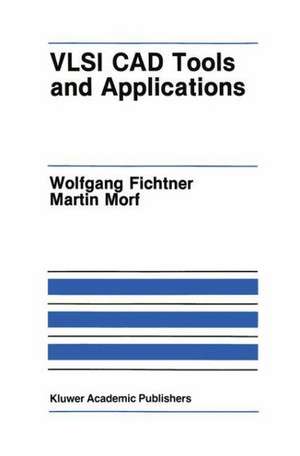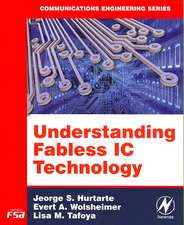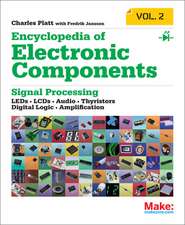VLSI CAD Tools and Applications: The Springer International Series in Engineering and Computer Science, cartea 24
Editat de Wolfgang Fichtner, Martin Morfen Limba Engleză Paperback – 12 oct 2011
Din seria The Springer International Series in Engineering and Computer Science
- 24%
 Preț: 1041.98 lei
Preț: 1041.98 lei - 20%
 Preț: 643.50 lei
Preț: 643.50 lei - 18%
 Preț: 1225.62 lei
Preț: 1225.62 lei - 18%
 Preț: 965.02 lei
Preț: 965.02 lei - 20%
 Preț: 646.12 lei
Preț: 646.12 lei - 18%
 Preț: 948.79 lei
Preț: 948.79 lei - 20%
 Preț: 646.62 lei
Preț: 646.62 lei - 15%
 Preț: 637.46 lei
Preț: 637.46 lei - 20%
 Preț: 643.83 lei
Preț: 643.83 lei - 18%
 Preț: 949.23 lei
Preț: 949.23 lei - 20%
 Preț: 644.48 lei
Preț: 644.48 lei - 20%
 Preț: 994.92 lei
Preț: 994.92 lei - 20%
 Preț: 645.97 lei
Preț: 645.97 lei - 18%
 Preț: 946.87 lei
Preț: 946.87 lei - 20%
 Preț: 995.57 lei
Preț: 995.57 lei - 18%
 Preț: 956.99 lei
Preț: 956.99 lei - 20%
 Preț: 644.98 lei
Preț: 644.98 lei - 15%
 Preț: 649.54 lei
Preț: 649.54 lei - 18%
 Preț: 950.21 lei
Preț: 950.21 lei - 18%
 Preț: 1221.38 lei
Preț: 1221.38 lei - 18%
 Preț: 957.62 lei
Preț: 957.62 lei - 15%
 Preț: 643.99 lei
Preț: 643.99 lei - 18%
 Preț: 948.47 lei
Preț: 948.47 lei - 18%
 Preț: 947.35 lei
Preț: 947.35 lei - 20%
 Preț: 1284.65 lei
Preț: 1284.65 lei - 20%
 Preț: 1628.31 lei
Preț: 1628.31 lei - 20%
 Preț: 1285.78 lei
Preț: 1285.78 lei
Preț: 404.13 lei
Nou
Puncte Express: 606
Preț estimativ în valută:
77.34€ • 80.45$ • 63.85£
77.34€ • 80.45$ • 63.85£
Carte tipărită la comandă
Livrare economică 14-28 aprilie
Preluare comenzi: 021 569.72.76
Specificații
ISBN-13: 9781461291862
ISBN-10: 1461291860
Pagini: 572
Ilustrații: 576 p.
Dimensiuni: 155 x 235 x 30 mm
Greutate: 0.79 kg
Ediția:Softcover reprint of the original 1st ed. 1987
Editura: Springer Us
Colecția Springer
Seria The Springer International Series in Engineering and Computer Science
Locul publicării:New York, NY, United States
ISBN-10: 1461291860
Pagini: 572
Ilustrații: 576 p.
Dimensiuni: 155 x 235 x 30 mm
Greutate: 0.79 kg
Ediția:Softcover reprint of the original 1st ed. 1987
Editura: Springer Us
Colecția Springer
Seria The Springer International Series in Engineering and Computer Science
Locul publicării:New York, NY, United States
Public țintă
ResearchCuprins
1 VLSI Design Strategies.- 1.1 Introduction.- 1.2 VLSI Complexity.- 1.3 The Design Spectrum.- 1.4 The Role of CAD Tools.- 1.5 The Role of the Designer.- 1.6 The Synthesis Project at Berkeley.- 1.7 Conclusions.- 1.8 References.- 2 Introduction to VLSI Design.- 2.1 Introduction.- 2.2 The MOS Transistor.- 2.3 Inverter Circuits.- 2.4 Generalized Inverter Circuits.- 2.5 Transmission Gates.- 2.6 Full Adders.- 2.7 Programmed Logic Arrays.- 2.8 Clocked Circuits.- 2.9 Finite-State Machines.- 2.10 Integrated Circuit Fabrication.- 2.11 Design Rules.- 2.12 References.- 3 Simulation Tools for VLSI.- 3.1 Introduction.- 3.2 Circuit-Level Simulation.- 3.3 A Linear Model for MOS Networks.- 3.4 A Switch Model for MOS Networks.- 3.5 Gate-Level Simulation.- 3.6 References.- 4 Aspects of Computational Circuit Analysis.- 4.1 Introduction.- 4.2 Formulation of the Circuit Equations.- 4.3 Table Representations of Devices.- 4.4 Linear Algebra Techniques.- 4.5 Newton-Like Methods.- 4.6 Continuation Methods.- 4.7 Time-integration Schemes.- 4.8 Macromodeling of Circuits.- 4.9 References.- 5 VLSI Circuit Analysis, Timing Verification and Optimization.- 5.1 Introduction.- 5.2 Circuit Analysis.- 5.3 Timing Verification.- 5.4 Circuit Optimization.- 5.5 References.- 6 CAD Tools for Mask Generation.- 6.1 Introduction.- 6.2 Advantages.- 6.3 Mechanisms.- 6.4 ABCD.- 6.5 Design Capture.- 6.6 Compaction.- 6.7 Technology Encapsulation.- 6.8 Software Engineering.- 7 Design and Layout Generation at the Symbolic Level.- 7.1 Introduction.- 7.2 The Role of Symbolic Representation.- 7.3 EDISTIX.- 7.4 TOPOGEN.- 7.5 ZORRO.- 7.6 Conclusions.- 7.7 Acknowledgements.- 7.8 References.- 8 Overview of the IDA System: A Toolset for VLSI Layout Synthesis.- 8.1 Introduction and Background.- 8.2 Key Ideas in IDA.- 8.3 IMAGES: aSymbolic, Constraint-Based Generator Design Language.- 8.4 Compaction and Assembly.- 8.5 Layout Synthesis.- 8.6 Other Tools and Features of IDA.- 8.7 Summary.- 8.8 References.- 9 CAD Programming in an Object Oriented Programming Environment.- 9.1 Introduction.- 9.2 The Programming Environment.- 9.3 The Organization of NS.- 9.4 Design Verification in NS.- 9.5 Physical Design in NS.- 9.6 History and Results.- 9.7 References.- 10 Trends in Commercial VLSI Microprocessor Design.- 10.1 Introduction.- 10.2 Historical Design Practice.- 10.3 Current Design Practice Details.- 10.4 Future Designs.- 10.5 Forecast.- 10.6 Summary.- 10.7 References.- 11 Experience with CAD Tools for a 32-Bit VLSI Microprocessor.- 11.1 Introduction.- 11.2 Top Down Simulation.- 11.3 The Interpreter.- 11.4 Architectural Simulator.- 11.5 Functional Simulator.- 11.6 Schematic Logic Drawings: Draw.- 11.7 Switch Level Simulation: Soisim.- 11.8 Backporting: Switch Level Simulation Without Vector Files.- 11.9 Layout Tools: Mulga.- 11.10 Circuit Extraction: Goalie.- 11.11 Netlist Comparison: Gemini.- 11.12 Timing Analysis: ADVICE and Leadout.- 11.13 Naming Conventions.- 11.14 Control the Source Code.- 11.15 UNIX.- 11.16 Some Statistics.- 11.17 Weak Spots.- 11.18 Results.- 11.19 Conclusion.- 11.20 References.- 12 Overview of a 32-Bit Microprocessor Design Project.- 12.1 Introduction.- 12.2 Processor Description.- 12.3 High Level Decisions and Influences.- 12.4 Design Tools.- 12.5 Division of Labor.- 12.6 Problems.- 12.7 Important Results and Conclusions.- 12.8 References.- 13 Architecture of Modern VLSI Processors.- 13.1 Introduction.- 13.2 Microprocessor Architecture Design Considerations.- 13.3 Memory Management Architectures.- 13.4 Memory Interfacing Peripherals.- 13.5 Summary.- 13.6 Acknowledgments.- 13.7 References.- 14 A Comparison of Microprocessor Architectures in View of Code Generation by a Compiler.- 14.1 Introduction.- 14.2 The Target Architectures and Their Instruction Formats.- 14.3 Code Generation.- 14.4 Measurements.- 14.5 Conclusions.- 14.6 References.- 15 Fault Tolerant VLSI Multicomputers.- 15.1 Introduction.- 15.2 Fault Tolerance.- 15.3 Self-Checking Nodes.- 15.4 Defects and Faults in VLSI.- 15.5 Self-Testing Comparators in VLSI.- 15.6 Implementation Issues.- 15.7 System Level Protocols.- 15.8 Conclusions.- 15.9 References.- 16 The VLSI Design Automation Assistant: An IBM System/370 Design.- 16.0 Introduction.- 16.1 Conception.- 16.2 Birth.- 16.3 First Steps.- 16.4 The IBM System/370 Experiment.- 16.5 Summary.- 16.6 References.- 17 Higher Level Simulation and CHDLs.- 17.1 Introduction: Why CHDLs?.- 17.2 Early Phases of the Design Process.- 17.3 Introducing a CHDL and Its Use.- 17.4 CHDL-based Design Environments.- 17.5 Conclusions.- 17.6 Literature.- 18 New Trends in VLSI Testing.- 18.1 Introduction.- 18.2 The Test Assembler.- 18.3 The Test Advisor.- 18.4 Interface with the General Data Base.- 18.5 Conclusion.- 18.6 References.- 19 VLSI Testing: DFT Strategies and CAD Tools.- 19.1 Introduction.- 19.2 DFT Strategies.- 19.3 CAD-Tools.- 19.4 Conclusions.- 19.5 Literature.















